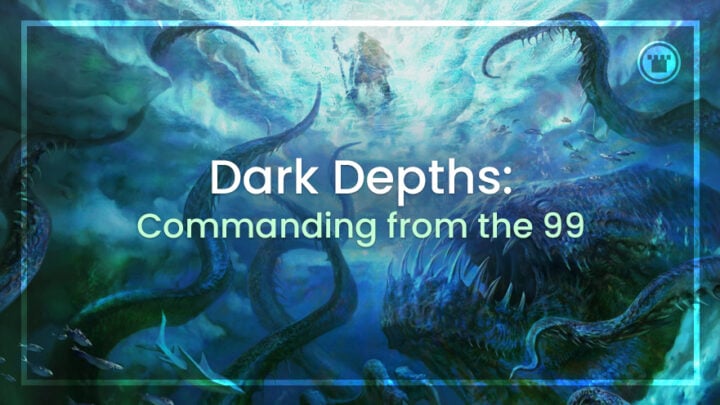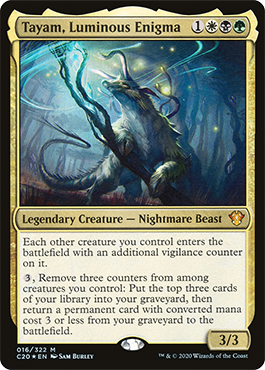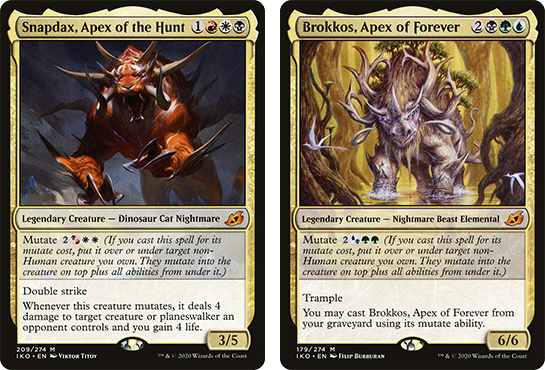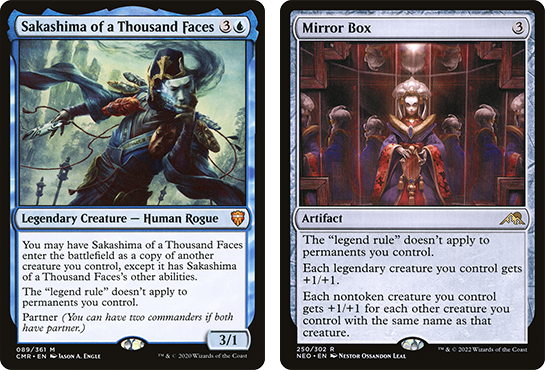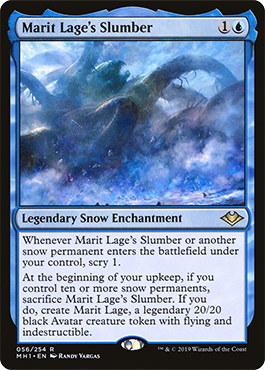The Commander format is all about celebrating your favorite cards, with special rules to ensure your chosen commander plays a major role in every game. But what if the card you really want to build around isn’t an eligible Commander choice? Or if it’s an older legendary creature whose rules weren’t designed to work within the special context of the format?
One path you could try is to simply house-rule (or “rule zero”) that it’s fine to play Skysovereign as your commander, or that the Myojin cycle still get their divinity counters when cast from the command zone. But many players don’t like the feeling of needing to get permission from opponents to play their own deck, especially at big events where you’re explaining yourself to new strangers almost every game.
In that case, it’s time to build around your card the old-fasioned way – maximizing its impact as part of your 99-card main deck!
Lately, I’ve been exploring ways to build a deck “commanded by” the most notorious legend to never (yet) get her own card: Marit Lage, the massive evil trapped inside Dark Depths. Obviously neither the 20/20 Avatar token nor Dark Depths can actually command the deck – but that just means it’s going to take extra commitment to let our tentacular star shine!
A Legacy of Evil
Obviously we still need to choose an actual commander at some point to have a legal deck. But I think we can wait on that until we figure out more of our gameplan. The commander is going to be just another cog in that machine, albeit an important one.
Since our build-around card isn’t going to be utilizing any Commander-specific rules, looking at how the card is used in other Constructed formats is much more relevant than usual. Marit Lage and Dark Depths have been metagame monsters in Legacy for over a decade, so it would be foolish to not use the tech and play patterns of those lists as at least the foundation of our own deck!
This includes deciding which colors we want access to: for Dark Depths, our deck clearly needs to be at least green-black. Green for all the powerful land-manipulation effects I talked about in my recent breakdown of that archetype, black for counter-removers like Vampire Hexmage and Hex Parasite, plus tutors and interaction.
Looking at Constructed decklists also seems to suggest we throw some white into the mix. Protection effects like Sejiri Steppe save Marit from removal and help brush past blockers. Knight of the Reliquary and Weathered Wayfarer are solid tutors which can dig up our combo: we can even add extra combo pieces like Solemnity.
White may not offer anything that green doesn’t give us already. But adding redundancy without losing quality really matters when you’re scaling up an archetype to a 99-card singleton list.
Digging for Depths
We’re lucky this time to have a powerful decklist which can inform our choice of colors and a lot of the key cards we’ll need. Even so, we can’t just expect to port the entire strategy between formats without further change. We always need to find more redundant versions of those effects if we want to ensure we draw them with a similar frequency.
Extra tutors are particularly important for efficiently locating our “true commander” to get it on the field sooner in more games. Recursion for Dark Depths is also a necessity – since we don’t have spare copies and we can’t just re-play it from the command zone, it’s our only way to keep our strategy rolling if (or rather, when) Marit Lage gets humbled by a Swords to Plowshares or Chaos Warp.
That’s a lot of extra work just to make up for the consistency you’d normally get free from the command zone. But being in Golgari colors does at least give us a creative way to combine card selection and recursion in a single mechanic.
Self-mill, particularly Life from the Loam, has always been integral to Lands as an archetype. Many other mill effects also include built-in land recursion, and cards like Ramunap Excavator can make up for those that don’t. Not all Legacy versions of Dark Depths play the Loam package, since 60-card decks with multiple tutors don’t have trouble finding their combo pieces – but it will really help us maintain consistency as we increase the size of our deck.
In fact, this mill-recursion loop is so integral to Marit Lage’s success that we should probably have it in our command zone. Tayam, Luminous Enigma gives us access to the three best Depths colors and its effect conveniently hits all of our combo pieces and interaction. It also offers us a slightly better deal on removing ice counters “the slow way” if we completely whiff on any other option! Even granting vigilance to our massive indestructible token is an important upgrade, squeezing just a bit more value out of our signature card.
Little “Fish”, Big Pond
Having filled the command zone, we can now return our attention to the gameplan: specifically our win condition, and how it translates to Commander. So far, all our energy is focused on making a 20/20 and swinging with it. That’s lethal in Legacy, but in a 40-life multiplayer game it’s suddenly up to a six-turn clock – not acceptable for the primary gameplan of our deck.
It’s hard to imagine ever killing the whole table in one turn with Marit beats – that’s just a compromise we’ll live with while playing this strategy. But we desperately need her to at least one-shot any player she does connect with – as much to retain the proper fear aura around Dark Depths as to improve our power level! We can look for cards that literally double power or damage, or we can try giving Marit double strike or infect.
An even sneakier plan would be to choose a commander with the mutate ability, giving us the incredibly satisfying option to have Marit attack for commander damage! Alas, only Snapdax makes her immediately lethal on its own.
There’s also the option to just attack twice in a row using extra combat phases or extra turns. This would also unlock a high-roll scenario where we potentially sweep the whole table without letting opponents untap. But given how tightly those effects are locked to red and blue, this would also require us to change commanders – and I don’t think it’s worth giving up all the advantages of Tayam when we have other solutions in-color.
Frozen Reflections
Another upside of “commanding from the 99” is that it adds a new level of deckbuilding flexibility around our central card. By changing our official commander, we can pivot into a different set of colors or even an entirely new plan for using our “true commander” without giving up our identity.
In this case, thinking about the recursion potential of Tayam and how to “double up” the 20/20 Marit Lage token gave me an idea: finding ways to have more than one Marit Lage in play at once. Copying and token-making effects which sidestep the legend rule are more and more common these days, and we can add a few cards which disable the rule altogether.
Obviously such a clone-heavy deck would need a blue color identity. Sakashima of a Thousand Faces is the obvious choice: as with Tayam, we’re using the command zone to guarantee access to a rare and important enabling effect.
Sakashima’s partner clause means we still have a choice of adding other colors. It would probably be best to just add the blue onto a standard green-black or green-white package – although it’s possible we just stick to green-blue, and accept having fewer combos which produce an instant Marit Lage. We’d still have the most important one – Thespian’s Stage – and Mirage Mirror to back it up.
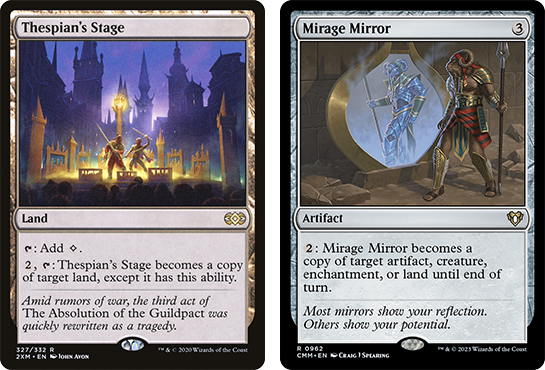
Making a permanent that’s already in play into a copy of Dark Depths will not place ice counters on it, meaning you’ll instantly trigger the second ability and unleash the darkness within!
We can also try adding Marit Lage’s Slumber as a completely new way of getting our star Avatar onto the battlefield – all it would really require is switching to snow lands. Even if it takes a little longer to get to that point, blue’s interaction makes me feel more comfortable playing a slow game – and would be excellent for protecting Marit once she shows up.
Iä, Iä, Marit Fhtagn!
We still aren’t even close to exhausting the different ways we can build a Commander strategy around Dark Depths. A red-green version of Lands could create huge hasty Avatars to crank up the surprise factor. A white-black Stax type deck could take advantage of the low-cost wincon and low-spell-count deck to crank up the taxes on people trying to play more “normally”
The important point is that you can absolutely build a commander deck which revolves around a card from your 99, with the commander in a supporting role. It limits your creative options in some places and increases them in others. But what matters to me is feeling excited about your deck’s identity – and if you really love 20/20 avatars, then this style of deck will give you that same authentic thrill.

Tom’s fate was sealed in 7th grade when his friend lent him a pile of commons to play Magic. He quickly picked up Boros and Orzhov decks in Ravnica block and has remained a staunch white magician ever since. A fan of all Constructed formats, he enjoys studying the history of the tournament meta. He specializes in midrange decks, especially Death & Taxes and Martyr Proc. One day, he swears he will win an MCQ with Evershrike. Ask him how at @AWanderingBard, or watch him stream Magic at twitch.tv/TheWanderingBard.

